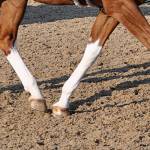Treatments, Supplements for Horses with Suspensory Ligament Injury

Inflammation of the proximal suspensory ligament, known as proximal suspensory desmitis (PSD), frequently causes lameness in performance horses. The condition can be manageable, but will shock wave or regenerative medicine give you the most bang for your buck?
“Ligamentous injuries in horses often recur despite extended time off to rest, giving horses with PSD only a guarded prognosis,” explained Catherine Whitehouse, M.S., a Kentucky Equine Research nutrition advisor.
Typically, horses with acute injuries have about a 90% chance of return to function after three months of strict stall rest and a controlled exercise routine. For horses with chronic lameness due to PSD lasting three months or longer, their chances of return to function drop to about 10-50%.
Treatment options for PSD, other than the conservative approach of extended stall rest, include extracorporeal shock wave therapy (ESWT) and directly injecting the injury with various therapeutics, including platelet-rich plasma (PRP).
“ESWT is a physical therapeutic technique that involves applying shock waves—intense, rapid, short energy pulses—directly to the injured region of the body. While it isn’t known exactly how the therapy works, some thoughts are that the shock waves recruit cells involved in healing and provide pain relief,” Whitehouse shared.
A recent study* was designed to evaluate whether ESWT or PRP was superior in managing PSD in 100 Western horses.
Researchers followed up on the horses one year after treatment and found:
- Horses with less severe lameness prior to treatment were 5.1 times more likely to be back in work one year post-treatment compared to horses with more severe lameness;
- Horses with less severe ultrasound changes to the PSD responded better to ESWT, whereas horses with more severe changes responded better to PRP;
- ESWT-treated horses were 3.8 times more likely to be back at work at one year compared to those treated with PRP regardless of the severity of the original injury to the PSD.
The study authors concluded that both modalities “can be expected to yield favorable therapeutic responses in Western performance horses with lameness localized to the proximal suspensory region. Baseline ultrasound may guide treatment selection.”
“Nutritional supplements designed to support the connective tissues of the horse’s musculoskeletal system, such as cartilage, ligaments, and tendons, include those containing chondroitin sulfate, glucosamine, and omega-3 fatty acids,” advised Whitehouse.
Look for Kentucky Equine Research’s high-quality joint supplements, especially Synovate HA which contains hyaluronic acid. Hyaluronic acid is a component of tendons and ligaments, and has been shown to stimulate collagen production. There is some support in the medical literature for its use in the management of human tendon and ligament injuries.
*Giunta, K., J.R. Donnell, A.D. Donnell, et al. 2019. Prospective randomized comparison of platelet rich plasma to extracorporeal shockwave therapy for treatment of proximal suspensory pain in western performance horses. Research in Veterinary Science 126:38-44.








